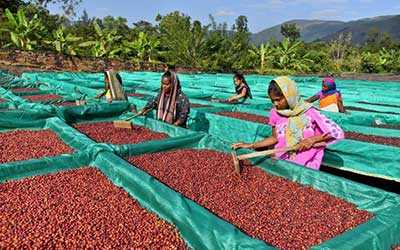Date: 19/05/2023
Relevance: GS-3: Major Crops - Cropping Patterns in various parts of the country; Indian Economy
Key Phrases: Agriculture commodity, Sustainable Value chain, Agri Commodities of Global Significance, Market and Producer Characteristics, Nature of Production, Governance Mechanisms and Policies, Adequate safety nets,
Why in News?
- India's agricultural sector has a rich history of producing commodities and has played a significant role in the global trade of spices, tea, and coffee for centuries.
- Over the past few decades, the sector has experienced remarkable growth, with high-value agricultural commodities contributing significantly to the country's GDP.
- However, this growth has come at a cost to the environment, as agricultural value chains contribute to carbon emissions, water depletion, and chemical misuse.
- Achieving sustainability in these value chains has become a pressing concern, and various challenges need to be addressed.
Agri Commodities of Global Significance:
- Certain agricultural commodities hold global significance based on their orientation towards international demand and supply through exports.
- These commodities, such as soybean, cocoa, coffee, tea, rubber, palm oil, and cotton, pose significant environmental and climatic risks, including deforestation, biodiversity loss, and soil degradation.
- In addition to these commodities, India needs to expand its focus to include imported commodities like oilseeds, domestically consumed fruits and vegetables, and commodities like rice and cotton, which receive significant attention in policy and action spaces.
- Transformative interventions in the production, trade, and consumption of these commodities can have a substantial impact on environmental sustainability.
Challenges to Sustainability
- Market and Producer Characteristics:
- Responsible and effective practices in commodity value chains depend on market dynamics and producer characteristics.
- Export-oriented commodities are influenced by India's export policies, consumer preferences, and sourcing regulations.
- For example, expanding cold storage facilities to enhance competitiveness in global markets increases energy demand, raising concerns about associated emissions.
- On the other hand, developing robust policies for production, processing, and retail can drive changes for the brand-agnostic Indian consumer.
- Holding agri-businesses accountable and ensuring compliance with sustainability commitments is crucial, while smallholders can benefit from low-cost certification and improved practices throughout the value chain.
- Nature of Production:
- The nature of commodity production, whether intensive or extensive agriculture or agroforestry systems, determines the appropriate interventions.
- Land-use strategies, seed quality, and input management play a significant role in determining the sustainability of production.
- Regional efforts that focus on climate, biodiversity, and livelihood benefits have demonstrated positive outcomes.
- For example, the introduction of biodiversity-friendly coffee in Karnataka has reduced human-animal conflicts, while the promotion of millets has widened consumer demand.
- Governance Mechanisms and Policies:
- Strong governance mechanisms and policies play a crucial role in supporting agricultural value chains.
- Subsidies, market access, and infrastructural support (extension services, processing, and storage facilities) are key elements of this support.
- Repurposing such support to promote sustainable production, sourcing, and consumption can have transformative effects on commodity value chains.
- Targeted regulation can incentivize agri-businesses to report and reduce environmental impacts in their supply chains.
- National guidelines on responsible business already encourage organizations to adopt sustainable practices and engage their suppliers, distributors, and partners in doing so.
- Inclusive Approach and Safety Nets:
- Environmental initiatives in agricultural value chains must prioritize the well-being of those dependent on these chains.
- Working conditions and labor rights issues are prevalent in commodity value chains in India.
- Responsibility for implementing policies and sustainability commitments often falls on marginalized individuals with limited agency.
- The success of environmental sustainability initiatives relies on the participation and support of marginalized actors.
- Adequate safety nets, such as rewarding compliance, supporting farm-level flexibility, and implementing robust insurance mechanisms, are essential for their inclusion.
- These measures should also consider the impact of the climate crisis on production.
Conclusion:
- Mitigating environmental impacts in agricultural commodity value chains is a challenging task due to its multidimensional nature.
- However, through concerted and coordinated action, supported by appropriate systems and a focus on equity and justice, agricultural commodity value chains have the potential to deliver positive outcomes for both India's people and the environment.
- Achieving sustainability in agri-commodity value chains requires addressing the challenges posed by market characteristics, production nature, governance mechanisms, and social equity.
- By doing so and capitalizing on opportunities, value chains can be transformed into sustainable and environmentally responsible systems that benefit all stakeholders and the ecosystem as a whole.
Source: The Hindu
Mains Question:
Q. Why is making agricultural commodity value chains sustainable a challenging task? Explain with reference to the multi-dimensional challenges faced by India in its efforts to mitigate environmental impacts while benefiting farmers, processors, and retailers.







